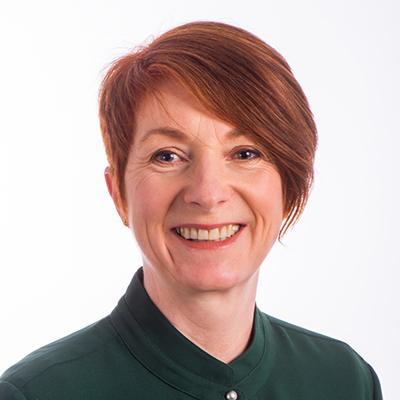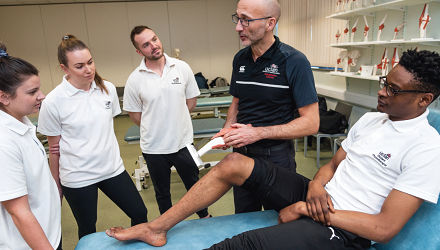Sylvia Wojciechowski, from Frimley Health NHS Foundation Trust, explains how she championed blended student placements from first contact physiotherapy to secondary care, working in conjunction with the Primary Care Training Hub, and providing an understanding of career pathways and advanced practice in primary care.

We were missing a trick by not offering student placements alongside our advanced practice physiotherapists, which would help students to understand the different career pathways and opportunities in primary care.
A blended style of placement would provide a broad prospective and allow students to develop their ‘system’ thinking and leadership potential so that they could recognise the value of collaboration right from the start.
I started to explore placement models in late 2020, and successfully introduced our first student placement across the acute trust and primary care in January 2021, working with advanced practitioners and first contact physiotherapists (FCPs).
Approach
Working closely with the local Primary Care Training Hub and two primary care networks, Farnham PCN and Oakley Health Group, we placed University of Winchester students.
Our blended model showcases the whole pathway to students, enabling them to see how a patient is managed from assessment and diagnosis in primary care (FCP) to treatment and discharge (secondary/community care). They also have the opportunity to take on an improvement project and attend regional and national meetings, such as Allied Health Professions in Quality Improvement.
In the past 12 months we have allocated 10 students in these four- to eight-week placements, with them spending one to two days a week in FCP clinics.
Supervision falls primarily to me and Anya Makin-Terry, learning environment lead for Frimley, Thames Valley and Wessex Primary Care School.
I manage the element that relates to FCP, secondary care, case discussions, clinical reasoning and project work. Meanwhile, Anya ensures that students spend time with other primary care teams and that their placement involves discussions about key strategic NHS developments.
Set-up and implementation
In December 2020, we were able to take on students within my immediate department (orthopaedics department at Frimley Health), which I’d wanted to do for some time. Anya and I devised a blended a model in which we would share the students each week, providing a taste of the various multidisciplinary teams in both primary and secondary care.
I discussed the opportunity with my team of FCPs and advanced practice physiotherapists, reminding them of the four pillars required for their career progress.
Just before we placed the first two students, the Covid pandemic struck, which meant reduced in-person clinics and a shift to virtual consultations. Many of the FCPs were under pressure and felt that hosting student placements would be too challenging. Nonetheless, in January 2021, we did offer our first placement. However, to overcome capacity issues I offered to be the main supervisor and cover certain responsibilities.
The majority of the initial eight-week placements involved virtual clinics, although both in-person and virtual consultations were observed. Once face-to-face clinics returned, we took two-three students at a time. When my service was at capacity, I reached out to an external FCP provider in our system to provide clinical support, which showed the students the value of system collaboration.
After the initial placements were successfully completed, more FCPs expressed interest in hosting placements; they wanted to continue because they recognised the value students bring and had enjoyed having them there.
Between one and three placements are hosted simultaneously, with supervision shifting from me and Anya to the team. We have daily check-ins and each team provides regular feedback to me or their main supervisor. We also use the CSP Common Placement Assessment Form (CPAF), which is a great was to support practice-based learning.
Prior to each placement, we talk with each student to understand their interests and learning needs so that we can plan their timetable accordingly.
Each week, the students share a piece of reflective writing about their learning to demonstrate their development. They also complete a project based on work that will benefit the service(s) they’ve observed and which relates to their studies and development. They present on this at the end of the placement.
Benefits
For the students
- This style of mentoring gives students time to develop their clinical reasoning and reflective practice.
- Students benefit from understanding the whole patient pathway.
- Working in primary care provides a better understanding of what FCPs can do and builds learning around why some patients may benefit from more focused treatments while others can self-manage. It also encourages students to think about when it is/isn’t appropriate to request investigations (i.e. imaging).
- Understanding primary care not only increases awareness but also demonstrates the value that we can offer as a profession.
- Students benefit from tailored learning that suits their individual interests and needs, for example, attending pulmonary rehab or Long Covid clinics.
For the clinicians
- The blended approach allows us to collaborate with other FCP providers in the system, supporting the integration of services while also helping students.
- Appreciating the benefits of supporting students, members of FCP staff and have completed the supervisor training course as part of the Health Education England roadmap.
- Advanced practitioners have said they benefit from the fresh perspectives of students, who bring new ideas to the table.
- Students' project work contributes to improving and developing the service.
For the wider system
- This shared/blended model has encouraged teams across the system to consider taking students.
- Sharing a student between providers has been successful and could be developed further.
- This way of working helps to embed co-design and collaboration, while supporting and developing our future workforce.
Outcomes
- We have facilitated 12 placements, with more planned.
- The team was extremely pleased with the achievements of year one; and the placement scheme is now fully embedded, providing regular placements.
- We have trained more supervisors, creating more flexibility and options for extending the placement offer.
Next steps
We aim to continue supervising one-two students at a time, and have aspirations to roll out the scheme in other services (the paediatric department have been inspired to create a similar blended model placement for a nursing student).
We intend to keep promoting student placements trust-wide, explaining why they’re needed and the benefits they bring.
We are considering how to build a leadership placement model blended with a care home placement, supporting occupational therapists and physiotherapists.
Key learning points and advice
- Don’t push FCPs who are reluctant to take a student. Ask them to spend a morning a week with the student, and you may find they are more willing to offer support next time.
- It can be challenging to coordinate feedback from all the different supervisors, but CPAF has really helped to support with this.
- Your local training hub is an excellent resource that you should tap into.
- Students have found case studies, clinical reasoning sessions and reflective writing extremely valuable.
- Reach out to other providers to share a placement or think about projects that would benefit both the students and the service/team.
- Use your contacts, and involve clinicians in non-clinical roles, as their knowledge and experience can really benefit students.




































